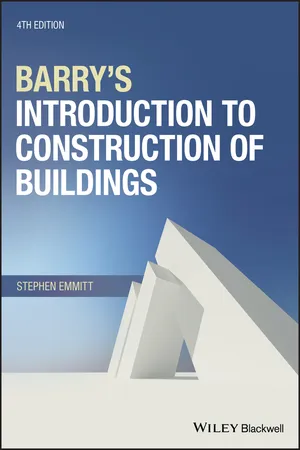
- English
- ePUB (mobile friendly)
- Available on iOS & Android
Barry's Introduction to Construction of Buildings
About this book
An authoritative, well-established, comprehensive, practical, and highly illustrated guide to construction practice
Based mainly on domestic and residential buildings—and filled with extensive illustrations throughout—this concise text is the ideal introduction to the subject of building construction. It provides the basic material that readers need in order to understand the construction process for the majority of low rise buildings. The book explains construction technology through the key functional and performance requirements for the main elements common to all buildings. With a strong focus on building efficiency and meeting the challenges posed by limiting the environmental impact of buildings, and new "at a glance" summaries allowing you to grasp the salient points of each chapter, readers will find the text fully up to date with the latest building regulations and construction technology.
Barry's Introduction to Construction of Buildings, Fourth Edition starts by taking an in-depth look at the construction process and general principles of construction. It then offers comprehensive chapter coverage of site analysis, set-up, drainage and scaffolding; ground stability and foundations; floors, walls, doors, windows, roofs, stairs, and ramps; surface finishes; internal environment and energy supply; and water supply and sanitation.
- Deals with design, technology, site assembly, and environmental issues of domestic and residential buildings
- Thoroughly updated, with particular attention paid to the concept of building efficiency and improved integration of the topics covered to match current student needs
- New "at a glance" summaries at the beginning of each chapter
- A companion to Barry's Advanced Construction of Buildings, Fourth Edition
Barry's Introduction to Construction of Buildings is an excellent source of information for undergraduate students and those working towards similar NQF level 5 and 6 qualifications in building and construction.
Frequently asked questions
- Essential is ideal for learners and professionals who enjoy exploring a wide range of subjects. Access the Essential Library with 800,000+ trusted titles and best-sellers across business, personal growth, and the humanities. Includes unlimited reading time and Standard Read Aloud voice.
- Complete: Perfect for advanced learners and researchers needing full, unrestricted access. Unlock 1.4M+ books across hundreds of subjects, including academic and specialized titles. The Complete Plan also includes advanced features like Premium Read Aloud and Research Assistant.
Please note we cannot support devices running on iOS 13 and Android 7 or earlier. Learn more about using the app.
Information
1
Introduction
1.1 The construction process
Genius loci – the importance of site
1.2 The function and performance of buildings
Function
- Provide shelter, security and privacy
- Provide structural and fire safety
- Ensure thermal comfort and wellbeing
- Have low environmental impact
- Be easy to use and operate (functionality)
- Be easy to maintain, repair and replace/upgrade
- Be adaptable and durable
- Be able to reuse and recycle materials and components at a future date
Performance
- Space, determined by the floor area and/or volume (and related to anticipated use)
- Thermal, visual and acoustic performance (quality of indoor climate)
- Design life and service life of the building and specific building components/elements
- Cost of construction, cost of use and cost of demolition/deconstruction and recycling
- Quality of the finished building (functionality, durability and usability)
- Appearance of the finished building (aesthetics)
- Environmental impact and ethical resourcing of materials and components
- Adherence to prevailing legislation and codes
Quality
- Quality control is a managerial tool which ensures that both work and products conform to predetermined performance specifications. This applies both to the design and the construction phases. Getting the performance specification right is an important step in achieving the required quality, be it for an individual component or the whole building.
- Quality assurance is a managerial system that ensures quality service to predetermined parameters. The ethos of total quality management aims at continual improvement and greater integration through a focus on client satisfaction. Manufacturers, contractors and professional consultants use this.
- Quality of the finished artefact will be determined by several variables that are constant for all projects – namely, the:
- Interaction and characteristics of the participants engaged in design, manufacture and assembly
- Effectiveness of ...
Table of contents
- Cover
- Table of Contents
- Preface
- 1 Introduction
- Chapter 2 AT A GLANCE
- 2 Site Analysis, Set‐Up, Drainage and Scaffolding
- Chapter 3 AT A GLANCE
- 3 Ground Stability and Foundations
- Chapter 4 AT A GLANCE
- 4 Floors
- Chapter 5 AT A GLANCE
- 5 Loadbearing Walls
- Chapter 6 AT A GLANCE
- 6 Roofs
- Chapter 7 AT A GLANCE
- 7 Windows
- Chapter 8 AT A GLANCE
- 8 Doors
- Chapter 9 AT A GLANCE
- 9 Stairs and Ramps
- Chapter 10 AT A GLANCE
- 10 Surface Finishes
- Chapter 11 AT A GLANCE
- 11 Internal Environment and Energy Supply
- Chapter 12 AT A GLANCE
- 12 Water Supply and Sanitation
- Index
- End User License Agreement